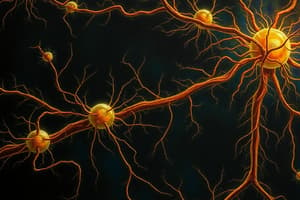Podcast
Questions and Answers
What is the major mechanism for controlling the production of a protein encoded by a given gene?
What is the major mechanism for controlling the production of a protein encoded by a given gene?
- Ribosomal regulation
- Post-translational modification
- Transcriptional control (correct)
- DNA replication control
In unicellular organisms, genes are regulated to adjust to changes in which environments?
In unicellular organisms, genes are regulated to adjust to changes in which environments?
- Microbial and ecological
- Biological and physiological
- Chemical and genetic
- Nutritional and physical (correct)
Roughly half of the genes in E. coli are organized into what structures?
Roughly half of the genes in E. coli are organized into what structures?
- Chromosomes
- Ribosomes
- Plasmids
- Operons (correct)
What must E. coli RNA pol associate with in order to initiate transcription?
What must E. coli RNA pol associate with in order to initiate transcription?
What binds to the promoter of the lac operon?
What binds to the promoter of the lac operon?
What blocks the start site of transcription in the absence of lactose?
What blocks the start site of transcription in the absence of lactose?
What happens to transcription of the lac operon in the absence of lactose?
What happens to transcription of the lac operon in the absence of lactose?
What releases the lac repressor from the operator sequence, de-repressing transcription?
What releases the lac repressor from the operator sequence, de-repressing transcription?
What is a better energy source than lactose for E. coli?
What is a better energy source than lactose for E. coli?
What does E. coli synthesize in response to low glucose levels?
What does E. coli synthesize in response to low glucose levels?
What protein does cAMP bind to and activate?
What protein does cAMP bind to and activate?
What greatly stimulates the rate of transcription initiation by interacting with RNA pol?
What greatly stimulates the rate of transcription initiation by interacting with RNA pol?
In the presence of high tryptophan levels, what happens to the trp operon?
In the presence of high tryptophan levels, what happens to the trp operon?
What are the major processes that regulate protein concentrations in eukaryotes?
What are the major processes that regulate protein concentrations in eukaryotes?
What controls cell protein concentration by gene transcription, mRNA degradation, protein translation, and protein degradation?
What controls cell protein concentration by gene transcription, mRNA degradation, protein translation, and protein degradation?
Flashcards are hidden until you start studying
Study Notes
Transcriptional Control in Prokaryotes and Eukaryotes
- E. coli RNA pol must associate with a sigma factor, commonly σ70
- σ70 binds to the promoter of the lac operon
- Lac repressor binds to the operator, blocking the start site when lactose is absent
- Transcription of the lac operon is repressed in the absence of lactose
- When lactose is present, it binds to the lac repressor, releasing it from the operator sequence and de-repressing transcription
- Glucose is a better energy source than lactose
- E. coli synthesizes cAMP in response to low glucose levels
- cAMP binds to and activates a transcriptional activator protein called CAP
- CAP interacts with RNA pol and greatly stimulates the rate of transcription initiation
- The trp operon is repressed in the presence of high tryptophan levels
- Cell protein concentration is controlled by gene transcription, mRNA degradation, protein translation, and protein degradation
- Major processes that regulate protein concentrations in eukaryotes include transcription, mRNA degradation, mRNA translation, and protein degradation
Studying That Suits You
Use AI to generate personalized quizzes and flashcards to suit your learning preferences.




